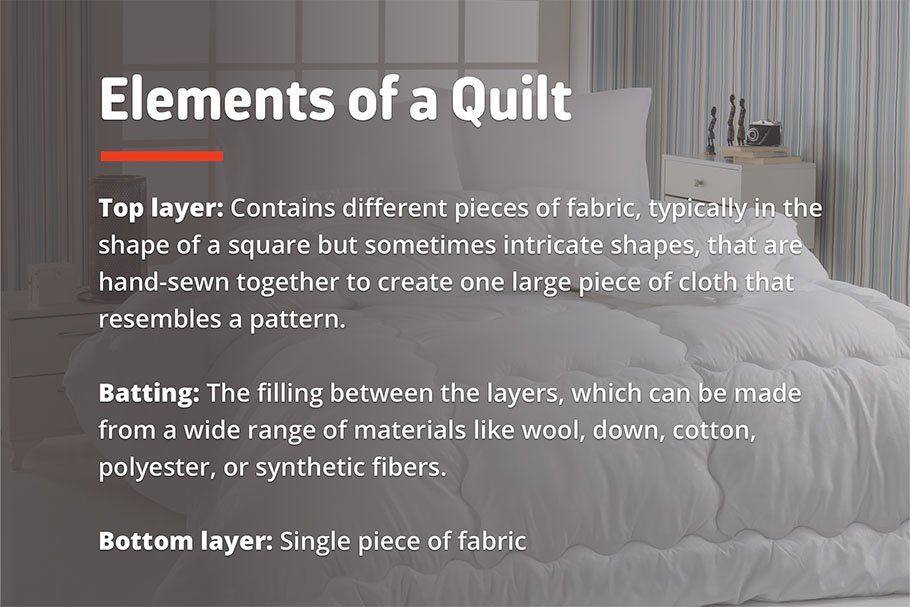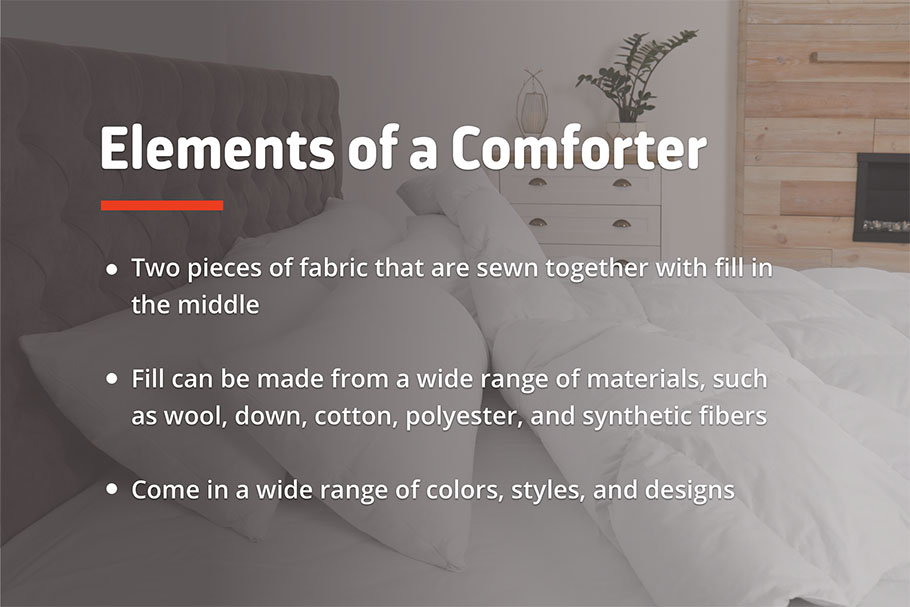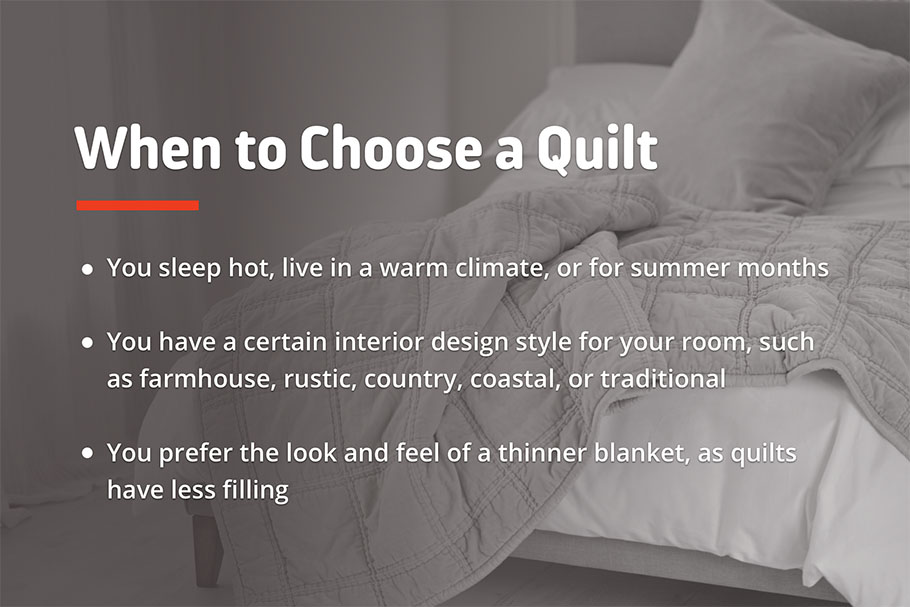Quilt vs. Comforter: What's the Difference?

Today we’re going to debunk the differences between quilts vs. comforters. As some of the most popular types of bedding options out there, it can be easy to confuse the two. In this guide, we’ll cover the differences between quilts and comforters, along with other frequently asked questions. So, which is better—quilt or comforter? Read below to find out, or use the links below to jump to a section that may hold the answer you’re looking for.
- What Is the Difference Between a Quilt and a Comforter?
- Is a Quilt Better Than a Comforter?
- Does a Quilt Go Over a Comforter?
- When to Choose a Comforter Instead of a Quilt
What Is the Difference Between a Quilt and a Comforter?
We know the importance of sleep and the role it plays in our quality of life. A good night’s rest can make us feel energized, help us grow and recover, and keep illnesses at bay. To achieve a night of deep sleep, the fabric you wrap yourself up in is important. The last thing you want is to sleep hot and wake up in a puddle of sweat or shiver with each passing hour trying your best to get warm. That’s where finding the right type of coverage comes in, so you can get the quality sleep your body deserves.
Quilts and comforters are just two of the options you have when it comes to finding the perfect bedding to whisk you away to sleep at night. While both seem similar at face value, they have significant differences that set them apart from one another. The main difference between quilts and comforters is how they’re constructed.
Quilts are typically thinner, comprised of three layers with batting in the middle, and are ideal for hot sleepers or those living in warmer climates. On the other hand, comforters are relatively thicker and have more fill power, making them fluffier and ideal for cold sleepers or those living in cooler climates. Let’s explore quilts and comforters in more detail below.
Quilts
If you think of any old western movie or a TV show set in the country, you might remember a unique blanket draped across a chair or spread across a bed with different pieces of fabric that create a pattern. These blankets are called quilts and contain three layers:
- Top layer: The top layer of a quilt is what makes quilts stand apart from other types of bedding. Traditional quilts contain a top layer of different pieces of fabric, typically in the shape of a square but can sometimes have a more intricate shape. These pieces of fabric are then hand-sewn together to create one large piece of cloth, and often have patterns on them or contain vibrant colors. Once sewn together, they might resemble a pattern. However, more modern quilts that are mass-produced are sewn with a sewing machine and their patterns are typically dyed.
- Batting: The inner layer of a quilt is called the batting, which can be made from a wide range of materials, such as wool, down, cotton, polyester, or synthetic fibers. The material used is what provides comfort, and is sewn between the top layer and the bottom layer.
- Bottom layer: The bottom layer of a quilt is traditionally one large piece of fabric that doesn’t resemble the more intricate design of the top layer.

To create a quilt, the quilter will sew all three layers together and create the trademark grid pattern that makes quilts stand out. Because they are relatively thin and breathable, quilts are ideal for hot sleepers, summer months, or those living in warmer climates.
Quilting is an art form that has been around for centuries and continues to be a popular bedding choice for most sleepers. Not only do quilts keep sleepers warm and comfortable throughout the night, but they add personality and charm to any bedroom, and are often compatible with farmhouse, traditional, rustic, country, and coastal interior designs.
Comforters
Similar to quilts, comforters are placed right over your mattress and sheets. Besides this main similarity, comforters are quite different. Comforters are much thicker than quilts and are fairly simple in design, either being a single neutral color or having a dyed design on top. The stitching on comforters is also fairly simple and doesn’t follow an ornate design, and typically only has stitching along the sides to keep the fill in place.
When it comes to filling, there are a few different materials that can be used, such as cotton, wool, down, down alternative, polyester, or synthetic fills. And because comforters are easy to produce and manufacture, they can come in a wide range of designs to match any type of interior design.

As for temperature, comforters run hotter than quilts because they contain more filling. However, there are plenty of comforters on the market that contain breathable materials that can keep you cool without compromising comfort.
It’s also important to note the difference between duvets vs. comforters, as they’re often used interchangeably. Comforters are a large, single quilted pouch that can come in a wide range of styles and designs. On the other hand, duvets are large pouches filled with down or other materials and typically require a duvet cover that’s similar to a pillowcase. Comforters are generally thinner, while duvets contain more fill and don’t require the use of a top sheet.
Is a Quilt Better Than a Comforter?
Now that you know the main qualities of both quilts and comforters, you may be wondering if you should get a quilt instead of a comforter, or vice versa. When it comes to the question — is a quilt better than a comforter? — the answer is, it depends. There are several factors to take into consideration if you’re stuck deciding between a quilt or a comforter.
Here are some things to consider to determine if a quilt is right for you:
- You sleep hot: If you’re a hot sleeper, a quilt might be right for you. Quilts are more lightweight than comforters and are great for summer, hot sleepers, and warmer climates.
- Design: If you’re going for a certain interior design style for your room, such as rustic, country, or traditional, a quilt will tie your room together to create the look you’re going for.
- Firmness: Because quilts are thinner with less filling between the top and bottom layers, they’re much flatter and firmer than comforters. If this is comfortable for you, a quilt will suffice.

In addition to these considerations, make sure to look at the care instructions for the quilt you’re looking at. Some quilts may require professional cleaning, while others can be washed right at home.
Does a Quilt Go Over a Comforter?
Yes, a quilt can be layered right over a comforter. Because quilts are thin, they serve as a great layered accessory if you want the fluffiness of a comforter but the design of a quilt. Putting a quilt over a comforter can also add more warmth if you’re a cold sleeper, so you can stay cozy all night long.
When to Choose a Comforter Instead of a Quilt
Which is better — a quilt or comforter? This is a common question, and we already know quilts are more ideal for hot sleepers or those looking to add a certain style to their bedroom. Comforters, on the other hand, are great for winter months, cooler months, or those who sleep cool. Below are some things to consider if you’re deciding between a quilt or comforter:
- You sleep cool: If you’re a cold sleeper, live in a cooler climate, or blast the air conditioning at night, a comforter might be the right choice for you, thanks to its added filling.
- Comfort: For sleepers looking for more comfort and fluffiness, comforters are a better option than quilts, as they have more fill in between their top and bottom layers.
- Flexibility: Comforters are one of the most popular types of bedding, meaning there’s a lot of flexibility when it comes to materials used and design. You can choose between down, cotton, wool, polyester, synthetic fabrics, and more when it comes to materials, and an ever-growing selection of design styles and colors.

Layla Sleep’s Down Alternative Comforter is made from 100% cotton, which is lightweight, breathable, and airy, resulting in a refreshing sleep for anyone who finds themselves wrapped inside. If you’ve decided between a quilt vs. comforter and went with the latter, read our down alternative comforter buying guide and review the pros and cons of down comforters to determine whether down alternative is the right choice for you.
At Layla Sleep, we also have our signature weighted blanket. What is a weighted blanket? Weighted blankets contain a heavy fill, such as glass beads, plastic beads, or sand, for example, to provide Deep Touch Pressure to relieve anxiety and stress to deliver a relaxing sleep. Read our blog on how to choose a weighted blanket to learn more. Here at Layla Sleep, we specialize in creating top-tier products to ensure you get quality sleep night after night.






